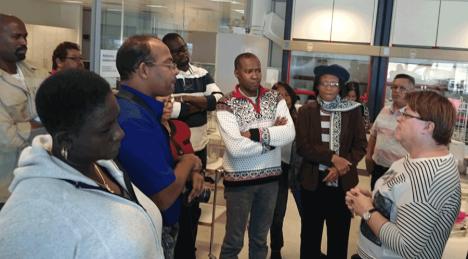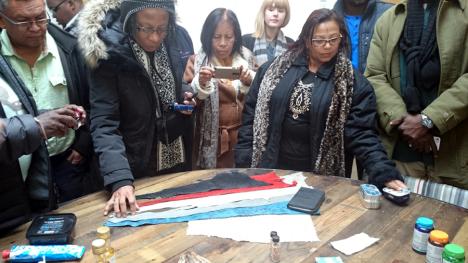BUILDING CARIBBEAN RESOURCES TO ENSURE SAFE SEAFOOD AND PROTECT AND GROW FISHERIES EXPORTS
Fuente: CRFM / CARIBBEAN NEWS NOW

Food safety chemist at Matis Laboratory discusses monitoring procedures with CARIFORUM professionals. (CRFM)

Trainees inspect various products from fish for the fashion, cosmetic and pharmaceutical industries. (CRFM)
BELIZE CITY, Belize (CRFM) -- Caribbean countries have a living bank of marine resources from which they collectively cash out hundreds of millions of dollars a year to support emerging national economies by providing good jobs, food and foreign exchange, among other benefits.
However, in order to remain active and competitive in the global marketplace, countries have had to find ways to surmount the challenges posed by stringent international standards called sanitary and phytosanitary (SPS) measures, for food safety and for protection against diseases carried animals and plants.
Under an EU-funded SPS Measures Project, the ability of Caribbean countries to effectively address those challenges is being strengthened through initiatives such as specialized training for those gatekeepers who help to ensure the safety of both imported and exported foods.
The project has reached a new milestone, as a group of professionals from CARIFORUM states -- the countries which make up the Caribbean Community, as well as the Dominican Republic -- has just concluded a sanitary and phytosanitary management course. The intensive two-week training, held at the United Nations University – Fisheries Training Programme (UNU-FTP) in Reykjavik, Iceland, was organized under the capacity building component of the project.
“I am very pleased that the 18 senior officials from our member states were able to participate in this important training opportunity to strengthen public sector capacities to effectively manage sanitary and phytosanitary systems for fish and seafood,” said Milton Haughton, executive director of the Caribbean Regional Fisheries Mechanism (CRFM), the agency coordinating the fisheries sub-component of the project.
“Developing SPS capacities is just a part of our overall strategy for improving competitiveness, adding value and building resilience to climate change, while addressing supply chain challenges facing the fisheries and aquaculture sectors in our countries,” Haughton added.
Susan Singh-Renton, the CRFM’s deputy director, who accompanied the trainees in Iceland, said: “Being onsite in Iceland over the past two weeks, participants were able to visit and speak directly with industry operators involved in fish handling and processing, virtual fish sale auctions, marketing, aquaculture, food safety research, technology development, and business networking for the creation of new products ranging from fashion leather to products for cosmetic and medical purposes. Not surprisingly, many industry operators emphasized that sustainable management of the natural fish resource was at the heart of Iceland's fishing industry development and SPS success story. Linked to this, discipline and dedication were evident at all levels of Iceland's fishing industry operations.”
Endhir Sosa, senior food safety inspector at the Belize Agricultural Health Authority (BAHA), participated in the SPS Management Course in Iceland. What he has learned from the Icelandic experience is that “[the] focus on improving food safety and quality along the entire food chain has led to an increase in the value of primary [export] products.”
Furthermore, collaboration between industry, government and academia, working hand in hand, has helped to ensure safe and high quality seafood products, he added.
“By all reports, the volume of the Icelandic catch has decreased throughout the years, in some cases by a half, but the value of exports has tripled,” Sosa noted.
The senior food safety inspector also detailed the knowledge he acquired to help ensure international SPS and food safety standards, not only for the exportation of Belize seafood but also for the importation of fish products, as well as inputs needed for the fisheries and aquaculture enterprises.
He said that three things caught his attention: The first is the ability to now trace products electronically rather than on paper. Integrating that modern technology, he said, “allows for a much more complete, accurate and faster trace of any fishery product.”
The second take-home message is about food fraud, which he said is important in an economy where direct sales of fish, especially fish fillets, have been established between fisherfolk and consumers, particularly in the tourism sector.
“Furthermore, Belize is a volume importer of foodstuff and in many cases [the labels are] in languages not our own, which makes us vulnerable to such illicit activities,” Sosa said.
Finally, there is the question of the true value of a fish, which goes beyond the food plate and extends to its use to make supplements, cosmetics, clothing, and post-surgical skin patches for burns and wounds worth over US$2,000 apiece.
“It's no longer only about fish fillets. Today, Iceland uses up to 82% of a cod fish caught,” Sosa said.
The Caribbean is looking at the Icelandic example to not just bolster its SPS regime, but also to expand the range of value added products from fish, and strengthen the value chain to maximize benefits across the spectrum, from fisher to processor to exporter. All along that chain, adherence to new SPS measures -- which are taking shape with plans to establish harmonized legislation across CARIFORUM states -- will be vital in helping to secure the region’s position on the global market.
There is a lot at stake. CARIFORUM countries exported nearly US$400 million worth of seafood and other marine products around the globe in 2015, with their biggest trading partners being the US and the EU, respectively.
Official trade data from those jurisdictions indicate that CARIFORUM states exported in excess of US$210 million worth of finfish, lobster and conch, as well as value added products such as fish sauces, to the USA in 2015. Additionally, they exported roughly US$75 million worth of marine products to the EU, the region’s second largest seafood trading partner, during the same time.








